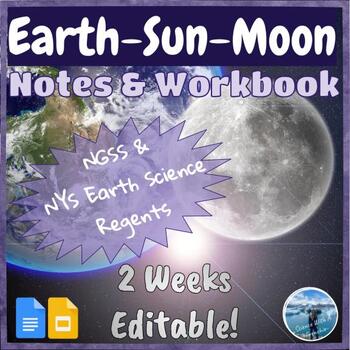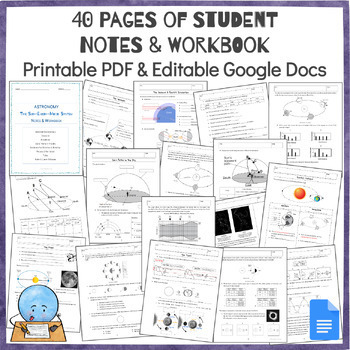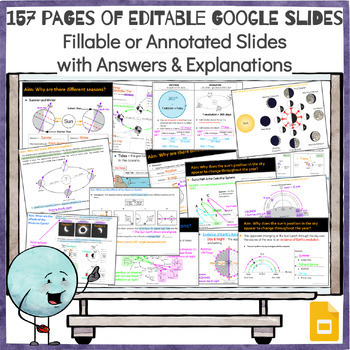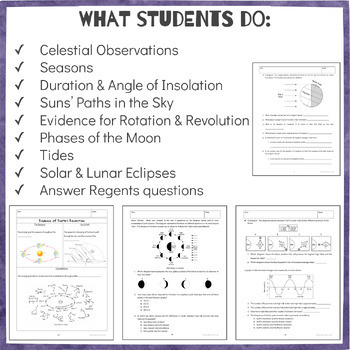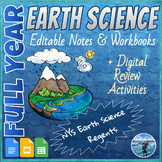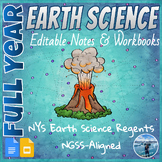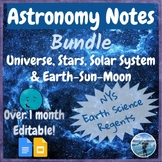The Earth-Sun-Moon System Notes & Workbook | Astronomy Unit | Editable | NYS
- PDF
- Google Apps™

Also included in
- This growing bundle includes everything your students need to know for the New York State (NYS) Regents Earth Science course.⭐ Save 20% ⭐This bundle includes 11 earth and space science notes and workbooks with associated digital review activities for the NYS ESRT, which are part of the explain and ePrice $181.60Original Price $227.00Save $45.40
- This growing bundle includes everything your students need to know for the New York State (NYS) Earth Science Regents course.⭐ Save 20% ⭐This bundle includes 12 units of earth and space science notes and workbooks. These notes can be used as standalone or as part of the explain and elaborate phasesPrice $133.60Original Price $167.00Save $33.40
- This complete astronomy bundle covers everything your students need to know about the Universe, Stars, the Solar System, and the Earth-Sun-Moon System for the New York State (NYS) Regents exam. It includes guided notes with practice questions and annotated teacher presentations in Google Slides. ThePrice $32.00Original Price $40.00Save $8.00
Description
This astronomy 2-week-long unit covers everything your students need to know about the Earth-Sun-Moon System for the New York State (NYS) Earth Science Regents exam. The students will learn about celestial observation, the seasons, duration & angle of insolation, the Sun’s paths in the sky, evidence for rotation & revolution, phases of the Moon, tides, and solar & lunar eclipses. They will also learn to read and use the "Solar System Data" chart on page 15 of the Earth Science References Tables (ESRT) and practice answering Regents questions. These guided notes are perfect for English Language Learners!
What's included?
- Student Workbook: 40 pages of notes with practice questions to share with your students. The workbook comes in 2 versions:
- Ready to print PDF
- Editable Google Docs™ file to allow you to modify as needed.
- Teacher Presentation: 157 Google Slides™ that go along the workbook. The slides come in 2 versions:
- Slides without the answers so that you can fill them in as you teach.
- Completed slides with answers, custom animations, links to web simulations and videos, and color-coded notes.
- Teacher Notes: 5 pages of pacing guide with learning objectives and standards.
What students do:
- The Seasons:
- Explain the two factors that cause the seasons: Earth’s revolution around the sun and the tilt of the Earth.
- Define equinox.
- Model the position of the Earth during the four seasons.
- Predict how much insolation the Equator, the tropics, the poles, and New York have at the different positions on the orbit.
- Sun’s Paths in the Sky:
- Model the apparent motions of the sun throughout the year.
- Predict the position of the sun in the sky for different months of the year.
- Predict the appearance and direction of shadows at different times of the day.
- Earth’s Motions:
- Explain Earth’s motions: rotation and revolution.
- Provide evidence of Earth’s rotation.
- Provide evidence of Earth’s revolution.
- The Phases of the Moon:
- Explain that the Moon’s cycle of phases is a cyclic event.
- Describe the Moon’s cycle of phases.
- Locate the position of the Sun, Moon, and Earth at each lunar phase.
- The Tides:
- Explain the forces that cause and affect tides.
- Analyze tidal change graphs and data.
- Forecast future high and low tide events.
- Compare spring tides and neap tides.
- Solar & Lunar Eclipses:
- Distinguish between lunar and solar eclipses.
- Model how lunar and solar eclipses occur.
- Predict when an eclipse is most likely to occur.
ESL Strategies: These notes are scaffolded for English Language Learners (ELLs):
- They contain many visuals and include minimal note-taking to allow more time to practice questions.
- Some videos are available in English and Spanish. You can also set the subtitles of the YouTube videos to auto-translate to have them in any language.
Please note that some of the videos are from BrainPOP. If your school doesn't have a subscription, you most likely can find them on YouTube.
Editable: You can edit all the Google Docs™ and Google Slides™.
You may also be interested in the following digital activities:
- The Moon & its Effect on Tides - Digital Lab Activity
- The Solar System - Notes & Workbook
- Universe & Star - Notes & Workbook
- NYS Earth Science Digital Lab Activities - Growing Bundle
- Pixel art reviews of the Earth Science Reference Tables - Digital Activities
⭐ My store is new, follow me for notifications about new digital and interactive activities that will be coming soon! ⭐

